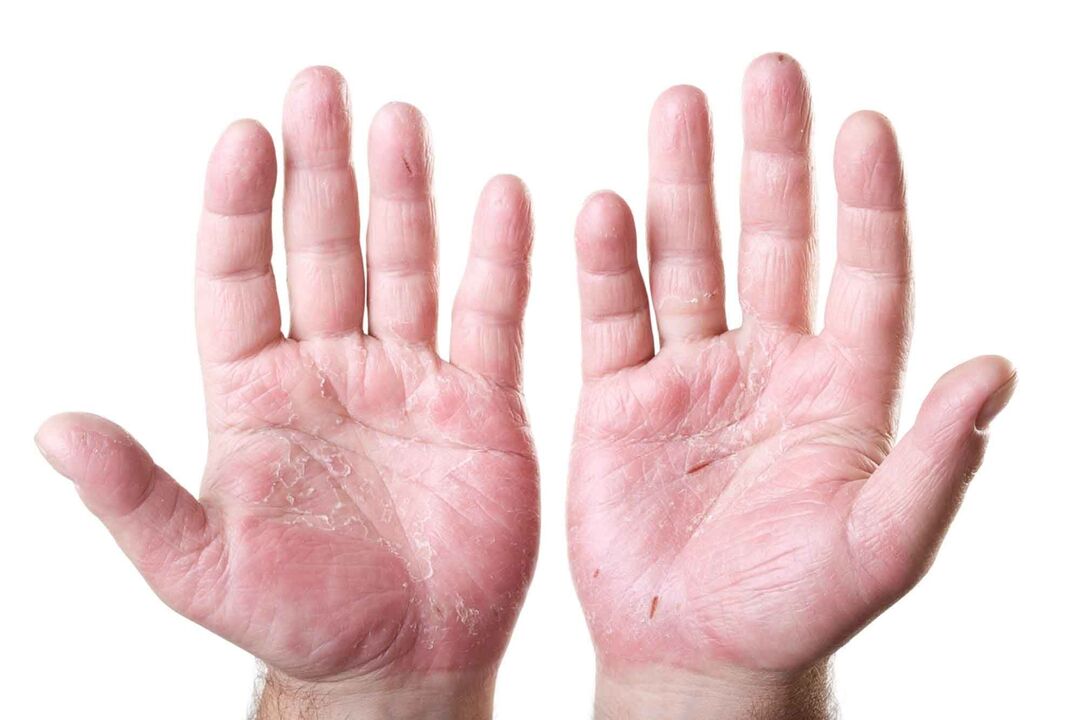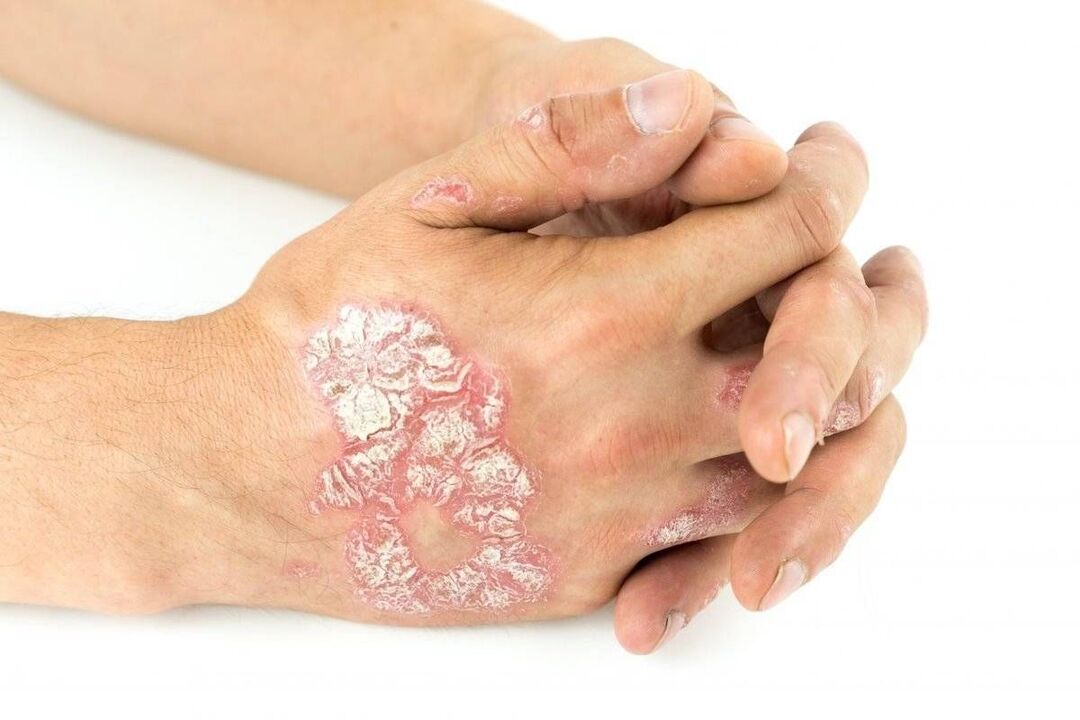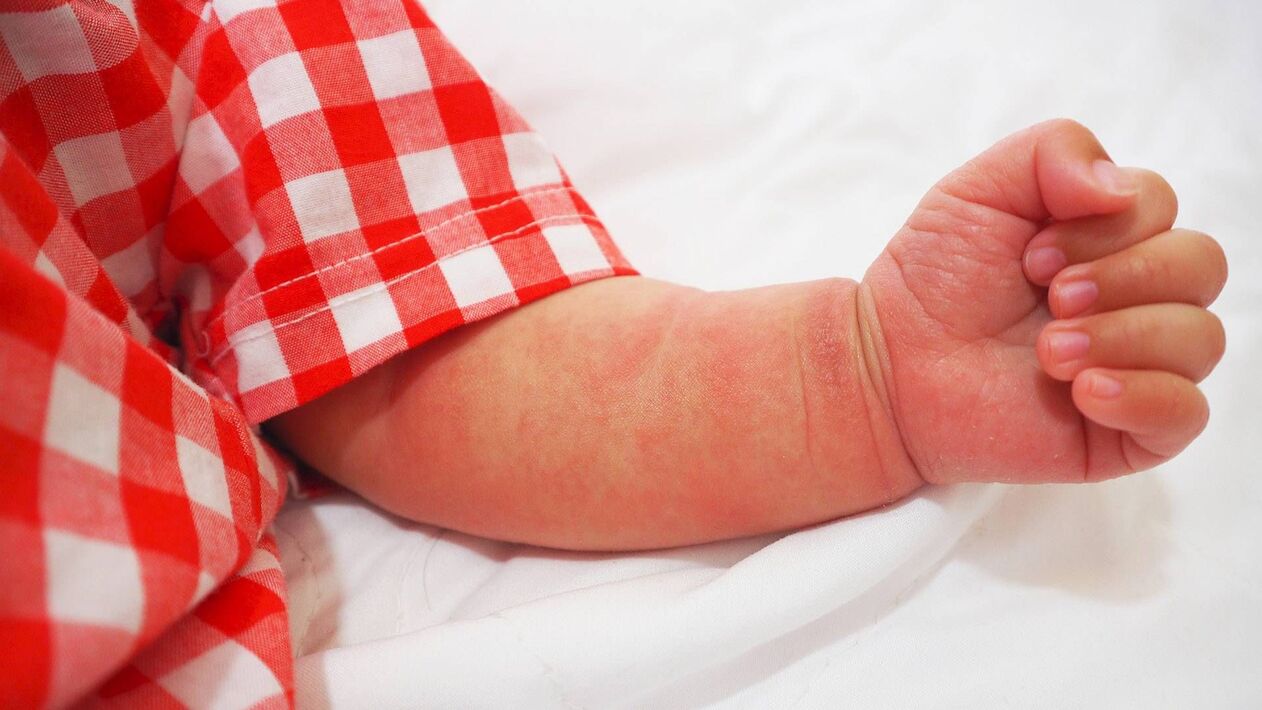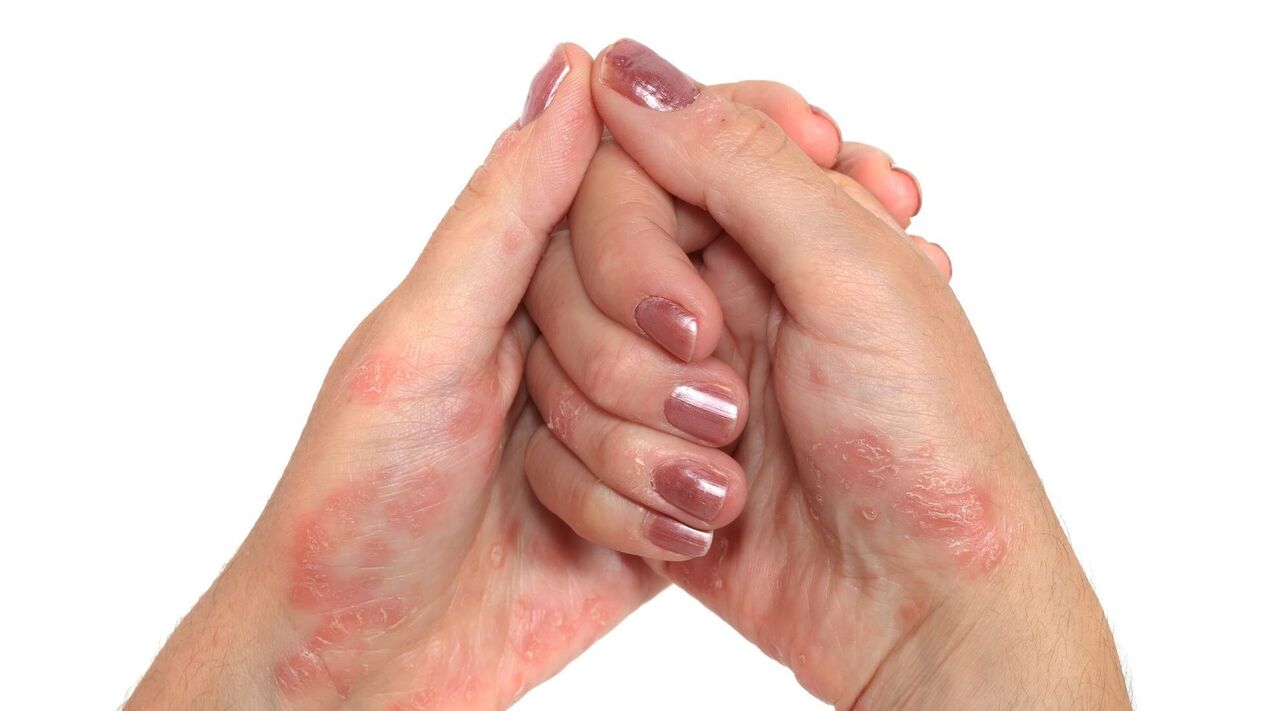This form of psoriasis is a chronic inflammatory disease that primarily affects:
- Palm.
- The area between the fingers.
- Hand.
Often, people suffering from this form of the disease develop serious psychological complexes.
This form of the disease does not pose a serious danger to human life, however, with the development of severe forms, the disease can be accompanied by the development of a number of very serious complications.
One of the most common complications is damage to the joints of the lower and upper limbs. This complication leads to the development of psoriatic arthritis. This disease is quite dangerous because it can lead to temporary disability, even disability.
Most people with hand psoriasis are diagnosed with lesions that appear specifically on the palms of the hands and soles of the feet.
This form of the disease causes the patient a lot of different inconveniences, since the main cause of the development of the disease cannot be hidden under clothes, and the formation of cracks is accompanied by the appearance of painful sensations. painful.
The lesions themselves are small, pink patches. The plaques become prominent on the skin's surface and are eventually covered with gray scales.
In some cases, the formation of yellow pustules can be observed.
The main symptoms of the development of this form of the disease:
- Dry skin.
- Thickens skin.
- Appearance of red color.
- Cracks appear.
- The appearance of the formations resembles callus.
reason
Among the many factors that can cause the disease are:
- Allergic reaction;
- Gastrointestinal diseases;
- Diseases of the kidneys, liver and pancreas;
- Excessive weight;
- Metabolic and endocrine system dysfunction;
- Genetic predisposition;
- Chronic depression, stress or nervous tension.
As we have noted, the exact cause of psoriasis remains unknown. Experts still cannot determine exactly what causes psoriasis and under what circumstances it appears.
At the same time, identify diseases or times that cause skin damage in patients:
- Genetic.
- Immune system disorders and metabolic problems.
- Psycho-emotional overload.
- Bad habits and eating disorders.
- General poisoning.
- Viral, bacterial, fungal infections.
- With drastic changes in climatic living conditions.
- In case of chronic skin diseases.
- If the patient takes drugs from different pharmacological groups for a long time.
Sometimes manifestations of the disease can occur if a person uses detergents that strip the skin of its natural covering. It's important to remember that psoriasis is not contagious, so you don't need to be too concerned about personal hygiene.
Different factors can cause eczema on hands:
- genetic predisposition;
- weakened immunity;
- disruption in the functioning of the endocrine glands;
- changes in hormone levels;
- Chronic diseases;
- infection;
- nervous tension;
- frequent stress;
- frequent contact with chemicals (detergents, paints, solvents) on the skin;
- uncontrolled drug use (eg, anti-inflammatory drugs);
- clothing made from synthetic fabrics;
- rings and bracelets made of certain alloys;
- cheap low quality cosmetics;
- pollen;
- Poplar fluff;
- Animal hair;
- Con middle base;
- mold;
- House dust;
- helminth infection;
- some food products.
The mechanism of psoriasis has not been fully determined, but it has been found that it is caused by a disorder in the process of skin cell division, in which diseased cells begin to multiply and grow. 5-10 times faster. Soon, immune cells participate in this process and blood vessels grow.
After the cells die, keratinized areas remain on the smooth surface of the skin - raised psoriatic plaques. In addition to genetic predisposition - characteristics of immunity, skin structure, indirect causes have been identified that influence the beginning of the development of psoriasis.
Recent medical research shows a link between the disease and other conditions:
- metabolic disorders (diabetes mellitus, hyperlipidemia, increased production of free radicals and nitrous oxide associated with skin keratinization);
- atherosclerosis;
- heart-related diseaes;
- liver and kidney diseases;
- Osteoporosis;
- fat.
Risk factors include:
- smoke;
- alcohol abuse;
- changing weather conditions.
You cannot get infected by coming into contact with a sick person; There are no outside disease carriers. Inflammatory processes occur in the body and a genetic predisposition to a specific disease cannot be ruled out. Other causes of psoriasis on hands are detailed below:
- impaired metabolism;
- hormonal imbalance;
- occupational hazards;
- tendency to allergic reactions;
- the presence of bad habits;
- poor nutrition;
- immune disorders of the body;
- Violation of personal hygiene rules.
Dermatological diseases are heterogeneous. There are exogenous and endogenous agents that cause disease.
Exogenous factors include environmental temperature fluctuations, bad habits, prolonged drug use, infections, injuries and diet that cause atherosclerosis. Endogenous factors include genetic predisposition, weakened immunity, stress and body sensitivity.
Irritating factors trigger the development of the pathological process. Modern dermatologists tend to consider psoriasis of the palms and soles to be the result of a combination of several agents.
The cause of the disease is not fully understood. Scientists identify several theories:
- Psoriasis is a genetic disease.
- Psoriasis appears due to disorders of the immune, endocrine and nervous systems.
- Psoriasis is a disease that appears due to poor ecology and the accumulation of harmful substances in the body.
When these reasons combine, psoriasis will appear. However, the main factor is still genetic: scientists have identified a number of genes as the cause of the disease.
Factors that stimulate the appearance of psoriasis:
- stressful situations;
- hazardous industries, especially those with high phenol concentrations;
- trauma, scratches, burns: sometimes psoriasis appears in these places;
- alcohol, smoking;
- infections: especially streptococcus;
- Wrong choice of certain drugs.
Why does palm psoriasis develop?
Psoriasis can appear in a person regardless of age and gender. However, there are some statistics showing that the disease develops frequently between the ages of 30 and 50 years old.
Scientists have discovered that the main causes of the development of this disease are dysfunction of the human immune system and genetic factors. However, these facts have not yet been fully proven and to this day the definitive cause of psoriasis remains unclear. The main factors causing palm psoriasis include the following reasons:
- Reduced immunity.
- Mechanical damage to the palm.
- Frequent hand contact with water.
- Hand skin is exposed to chemicals, such as household chemicals, as well as various products in the workplace.
- The cause is often diseases such as scarlet fever, chronic tonsillitis, kidney disease and others.
- Cancer.
Doctors believe that alcohol abuse, drug use and certain medications are another cause of the disease.
The main manifestations of psoriasis on the palms
It is worth noting that this type of disease occurs mainly in people who do physical work that is associated with stress on the hands. In medical practice, people often distinguish three types of diseases. Including:
- Fan-shaped plaque.
- Round shape.
- Heartless.
Types of psoriasis on hands
| Locating psoriasis on the hands | Describe the problem |
| On the palm of the hand | Redness of the palm skin surface, itching, roughness of the top layer, calluses appear. On the outside, many people confuse psoriasis on the palms with fungal disease or eczema. For an accurate diagnosis, you need to consult a specialist. |
| On hands and fingers | Inflammation, swelling of the fingers, peeling, cracking of the skin, pain and itching. |
Depending on the location of the process and the specific location of the appearance of primary lesions, several types of hand psoriasis are distinguished:
- Pustules - the most dangerous type, affecting all skin types. First, small spots appear on the knuckles and palms, associated with the nail plates. The nodules then merge, fill with pus, and the damage spreads to the hands and other areas, causing swelling and degeneration of organs.
- Teardrop shape - the rash is pale pink, convex, shaped like small drops. It is localized in the shoulders and forearms and develops over a large area.
- Nails – This type of psoriasis leads to changes in the appearance of the nails and nail bed. "Thimble symptom" is observed when the color of the nail plates changes and small dents and grooves form on them. At the same time, the nail thickens and begins to peel off, until it is completely gone.
- Plaque (Vulgar) – tops in prevalence. These are typical psoriatic plaques that tend to merge and form "paraffin lakes". They appear above the elbow joint, on the extensor surface of the arm and affect the palm of the hand. Palmar psoriasis is characterized by roughness of the epidermis and the formation of callous-like cracks on the surface of the dermis.
Stages of the disease
In the early stages of hand psoriasis, even before the first rash appears, the following disorders can be recognized:
- swelling is observed in the joint area;
- the skin is reddish in some places;
- nail plates become inflamed.

The following stages of psoriasis on the hands are distinguished:
- Acute exacerbation is the progressive stage of the disease. It is characterized by an increase in the number and size of spots, increased itching and peeling.
- Stable phase - it is characterized by a deterioration of the disease, a change in the color of psoriatic plaques (they become less red, more white), as well as a decrease in spots.
- The remission phase is characterized by the complete disappearance of all signs of psoriasis.

Seeing your hands affected by psoriasis is extremely uncomfortable. But this disease is so common that everyone must know what psoriasis on the hands looks like in order to detect the problem in time and start treating it promptly.
Hand psoriasis develops gradually. Doctors note that in medicine there are several stages of the disease, which can replace each other imperceptibly without timely treatment. The patient's clinical outcome depends entirely on timely response to treatment measures. The development and signs of different stages of psoriasis on the upper limbs are as follows:
- Initial stage. Small round papules with clear boundaries. At first, they are solitary, but 2-3 days after peeling of the dermis, they spread and cover large areas of damage.
- Progressive stage. The painful spots are bright red, in the center there is peeling of the epidermis and the formation of a crust. Pathology is preceded by microtrauma of the skin.
- Fixed phase. The once red rash will turn green and dry. The inflammatory process decreases in intensity, the itching stops, but there is still hyperemia on the skin.
- Regression phase. Local manifestations of psoriasis decrease in intensity and as painful lesions resolve. The remission period is long-lasting, no peeling, but white spots with clear boundaries can be seen.
Psoriasis in all forms and localities, including hand psoriasis, goes through 3 stages:
- Progressive stage (exacerbation) - spots grow, new ones appear, the manifestations of psoriasis increase.
- Stable phase - manifestations of the disease fade, the spots become pale and decrease in size.
- Regression phase (remission) - symptoms disappear completely.
The initial stages of psoriasis on the arms and hands can manifest themselves in different ways: the appearance of faint, barely noticeable spots or brightening immediately, as in the acute stage (rarelythan).
Characteristics of treatment in pregnant women and children
Because the mother's immunity is weak and the child's immune system is still immature, the treatment of eczema on the fingers requires:
- Adjust the diet of breastfeeding mothers and young children, limit drinking milk, eating green vegetables and fermented dairy products. At an older age, it is necessary to exclude flour products, smoked meats and foods high in salt from the child's menu.
- Take a vitamin complex to support the immune system of pregnant women.
- One of the recommended measures is to limit exposure to household chemicals and water.
- Use antihistamine ointment or dermatological medication.
For the treatment of children, the following drugs can be prescribed:
- Make lotion based on boric acid
- Taking calcium-based drugs, taking into account the reduced content of trace elements, characteristic of this pathology in children.
- The use of ointments containing antibiotics is done to relieve the symptoms of severe infections.
- The use of antihistamines to reduce the intensity of itching.

A series of measures aimed at restoring the health of mother and child should include compliance with personal hygiene standards and maintaining sanitary conditions of the premises.
Psoriasis on hands
Official medicine classifies hand psoriasis as a chronic disease with many causes. This means that the exact cause of the disease has not yet been determined and doctors consider them as possible factors. Doctors classify it as a skin disease based on its main symptoms - red scaly patches that appear on the skin. But the culprit that causes disease is hidden deep inside the human body.
During long-term research on the mechanism of psoriasis development, scientists have identified a connection with a decrease in autoimmunity.
The first signs of psoriasis appear on the hands in the form of small red papules with clear borders. 2-3 days pass and the papules are covered with scabs. Then, a long progression of the disease begins, marked by periods of exacerbation and remission. Therefore, psoriasis that initially occurs between the fingers can spread to the entire surface of the palm. The individual plates grow and fuse, forming a continuous scaly shell. The photo clearly shows what psoriasis looks like on your hands.

Changes first form on the back of the hand, gradually affecting both sides of the hand. Not being noticed at the beginning of the negative process, they lead to an obvious cosmetic defect, when it is already difficult for a person to hide the presence of the disease. What could happen?
Symptoms of psoriasis on hands
Characteristic symptoms of psoriasis on the hands need to be considered in the context of their manifestation on any part of the patient's body. When damage begins, small areas of the dermis are affected, but the process does not end there and over time, plaques can cover the entire hand. General symptoms look like this:
- the appearance of small papules;
- class formation;
- dry and peeling skin on hands;
- The nail plate loses its natural color, its structure changes;
- signs of skin hyperemia;
- the skin in the affected area becomes red;
- pain appears in the joints;
- feeling of discomfort inside.
We have given general signs of the disease, but experts have broken them down according to the stage of the disease.
What types of diseases exist?
The versatility of the manifestations of psoriasis encountered by physicians has forced them to describe different forms of the disease. Experts have combined the existing species into two main groups: pustular and non-pustular.
The pustular group includes the following forms of the disease:
- generalize;
- similar to annular centrifugal erythema;
- palmoplantar.
The group without pustules contained:
- Classic early- or late-onset form of psoriasis;
- psoriatic erythema.
The presented classification does not include diseases such as psoriasis, seborrhea, Napkin's disease, atypical and drug-induced psoriasis.
Causes of psoriasis on hands
Among the sites affected by the disease, the hands account for 85% of all diagnoses. Years of observation of patients suffering from an unpleasant disease have led scientists to conclude that the cause of psoriasis on the hands depends on the gender and age of the patient.
Psoriasis is extremely rare in black people. A scientific explanation for this fact has not yet been received.
What causes psoriasis on women's hands?

What doctors call genetic predisposition is the main reason. It is noteworthy that even if a woman's parents do not have psoriasis, perhaps one of her relatives has been so diagnosed. Other reasons include:
- climate characteristics (very humid, cold or hot);
- hormonal imbalance;
- bad habits (alcohol, smoking, drugs);
- stress and nervous tension;
- taking antibiotics, some vaccines, overdosing on vitamin preparations;
- wounds, burns, cuts.
The same reasons can make the disease worse. It is difficult to eliminate the factors listed from your life, but some of them can be eliminated.
What causes psoriasis on men's hands?
Trying to determine the main ones, doctors are forced to admit that they cannot establish them with great accuracy. The basis for the appearance of psoriasis on the hands in men is a malfunction of the immune system, which is expressed by:
- improper metabolism;
- imbalance of lipid and carbohydrate metabolism;
- increased sugar intake;
- cholesterol.
A higher likelihood of developing psoriasis awaits men who have had someone in their family with the disease. Possible reasons are:
- chronic lack of sleep;
- poor nutrition;
- cold climate.
People who migrate from the South to the North all believe that the cold climate makes the disease more severe and difficult to treat.
Causes of psoriasis on hands in children
In recent years, cases of diagnosis have become more frequent. It is often generalized, with patches covering large areas of the body. The first thing that was determined is that the cause of the disease is genetic factors. According to statistics, among parents of psoriasis patients, their children will inherit the disease in 50% of cases. In addition to genetic factors, the disease can also be caused by:
- infectious diseases in children (measles, ARVI, tonsillitis);
- stressful situations;
- extreme fear of losing loved ones;
- Sun stroke;
- unbalanced diet;
- hypothermia of the body;
- allergic tendency.
Diagnostic
It is enough for the doctor to know what psoriasis on the hands looks like to make an accurate diagnosis. No specific studies have been performed to identify the disease. If the patient says that the plaque on the hands has appeared for a long time, the doctor may prescribe additional tests. Their list includes:
- blood chemistry;
- general blood test to determine the amount of ESR;
- testing for rheumatoid factor and the presence of specific proteins;
- Biopsy is performed to detect immature skin cells, accumulation of Rete bodies, macrophages, and T leukocytes.
How to treat psoriasis on your hands?
Treatment of hand psoriasis depends entirely on the stage of the disease. Although the disease cannot be cured, when comprehensive treatment is applied, the symptoms become almost invisible and the period of remission lasts quite a long time.
External means
In the early and middle stages of the disease, the use of topical medications is sufficient. These can be creams and ointments from different groups:
- No hormones. As a rule, they do not cause side effects and their effects are very gentle.
- Hormonal.
These remedies are used when pronounced symptoms appear (persistent rash, brittle nails) when other ointments do not help. Prescribed only by a doctor, they can have strong side effects. The frequency and duration of external use of the drug depends on the severity of symptoms: 1-2 times a day for 10-20 days. After each course there must be a rest period.
Systemic medicine
Tablets and injections are prescribed when topical medications are ineffective in the later stages of psoriasis on the hands:
- Tablets: antihistamine, anti-inflammatory. Drugs belonging to the group of cytostatics, monoclonal antibodies, immunosuppressants, immunomodulators, sedatives and vitamins are also used.
- Injectable drugs: antihistamines, hepatoprotectors, immunosuppressants, immunomodulators, hormones.
The form and type of drug depend on the stage of the disease and the intensity of its manifestations. Systematic use of the drug is carried out only under the supervision of a doctor.
Physical therapy and traditional methods
Psoriasis is a long-term disease with multidimensional symptoms. Therefore, treatment is always comprehensive. Alternative methods that can be used:
- Physical therapy: phototherapy, bioresonance therapy and PUVA therapy, cryotherapy, ozone therapy, ichthyotherapy.
- Folk remedies: birch tar, linseed oil or sea buckthorn oil, aloe vera, bay leaf, baking soda, sea salt, etc. v.
Their purpose and usage must also be approved by a dermatologist.
Use herbs
Many medicinal herbs have the following properties:
- Anti-inflammatory;
- regeneration;
- Antimicrobial.
To treat psoriasis of the palms, celandine, St. John's wort, horsetail, oregano, nettle and others are used. An infusion or decoction is prepared from herbs. They are also used to add to bathrooms.
Treatment with soda
One of the methods alternative medicine offers to get rid of palmar psoriasis is regular baking soda treatment. Its use has the following effects on the affected skin area:
- clean;
- soften;
- Eliminates inflammatory processes;
- improves local blood circulation;
- eliminate peeling;
- relieves itching.
The recipe for preparing a solution for external use is quite simple: dilute a certain amount of product in purified water. You will get a thick mixture. This product must be applied to areas affected by disease. No need to rinse.
Prevention: what rules must be followed
Treating hand psoriasis will be easier if the factors that provoke the disease can be eliminated or minimized. In this case, treatment will be much more effective and the progression of the disease will stop.
The right therapy, even at the earliest stages, can only be prescribed by a specialist so examination is mandatory. As well as using all available methods and means: from ointments and creams to injections, pills and physiotherapy. The doctor will prescribe medication and dosage, but we must not forget about prevention even at the stage of regression. Hands need to be treated with extreme care: use protective creams and exclude harsh household chemicals.

























